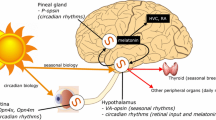Abstract
Effect of photoperiod on emergence rhythm of adult Spodoptera littoralis Bolsd. (Lep., Noctuidae)
Adult emergence ofSpodoptera littoralis Boisd. from pupae, reared since the egg stage at different photoperiodic conditions was studied. The photoperiods tested were: 8 hours light and 16 hours darkness (8L:16D), 10L:14D, 12L:12D, 16L:8D together with continuous light (24L:0D) and complete darkness (0L:24D), In the shortest day-length (8L:16D) all adults emerged at night, while in the longest one (16L:8D) 40%) only emerged during the dark period of the day. In the intermediate photoperiods, the percentage of the light-emerging moths increased with the prolongation of the photophase, thus at the photoperiods of 10L:14D, 12L:12D and 14L:10D such percentages were 9, 13 and 28 respectively. In cases where insects were reared in continuous light (24L:0D) or complete darkness (0L:24D), emergence took place at random and the rhythmicity disappeared. By transferring newly formed pupae, reared in complete darkness, to photoperiod of 12L:12D, adults emerged mainly during the dark phase (90%). On the other hand, when pupae reared in 12L:12D were transferred to complete darkness emergence took place at random (arrhythmic emergence). This indicates that the pupal stage is the sensitive one to phase regulation and not the larval stage.
Similar content being viewed by others
Literaturverzeichnis
Beck, S. D., 1968: Insect photoperiodism. Academic press, New York.
Bremer, H., 1926: Über die tageszeitliche Konstanz im Schlupftermine der Imagines einiger Insekten und ihre experimentelle Beeinflußbarkeit. Z. Wiss. Insektenbiol.21, 209–216.
Brett, W. J., 1955: Persistent diurnal rhythmicity inDrosophila emergence. Ann. Entomol. Soc. Am.48, 114–131.
Callahan, P. S., 1952: Behaviour of the imago of the corn earwormHeliothis zea (Boddie), with special reference to emergence and reproduction. Ann. Entomol. Soc. Am.51, 271–283.
Englemann, W., 1966: Effect of light and dark pulses on the emergence rhythms ofDrosophila pseudo-obscura. Experientia22, 606–608.
Goetz, B., 1949: Der Einfluß von Tageszeit und Witterung auf Ausschlüpfen, Begattung und Eiablage des SpringwurmwicklersSpargnothis pilleriana Schiff. Z. angew. Entomol.,31 (2), 261–274.
Jarcyzk, N., andB. Flaschenträger, 1957: Contribution to the biology and biochemistry of the cotton leaf-wormProdenia litura F. Bull. Soc. Entom. Egypte,41, 621–626.
Moriarty, F., 1959: The 24-hour rhythm of emergence ofEphestia kühniella Zell. from the pupa. J. Insect physiol.3, 357–366.
Pittendrigh, C. S., andV. G. Bruce, 1957: An oscillator model for biological clocks. In “Rhythmic and Synthetic processes in growth” (D. Rudnick, ed.), 75–109. Princeton Univ. Press, Princeton, New Jersey.
Pittendrigh, C. S., V. G. Bruce andP. Kaus, 1958: On the significance of transients in daily rhythms. Proc. Natl. Acad. Sci. U. S.44, 965–973.
Wiesmann, R., 1952: Report to the Government of Egypt on the control of cotton leaf worm (FAO-Report No. 32, Rome).
Author information
Authors and Affiliations
Rights and permissions
About this article
Cite this article
Abou-Elela, R.G., Zohdy, N.Z.M. Über die Wirkung der Photoperiode auf den Schlüpfrhythmus der Falter vonSpodoptera littoralis Boisd. (Lep., Noctuidae). Anz. Schadlingskde., Pflanzenschutz, Umweltschutz 48, 150–154 (1975). https://doi.org/10.1007/BF01876512
Issue Date:
DOI: https://doi.org/10.1007/BF01876512




